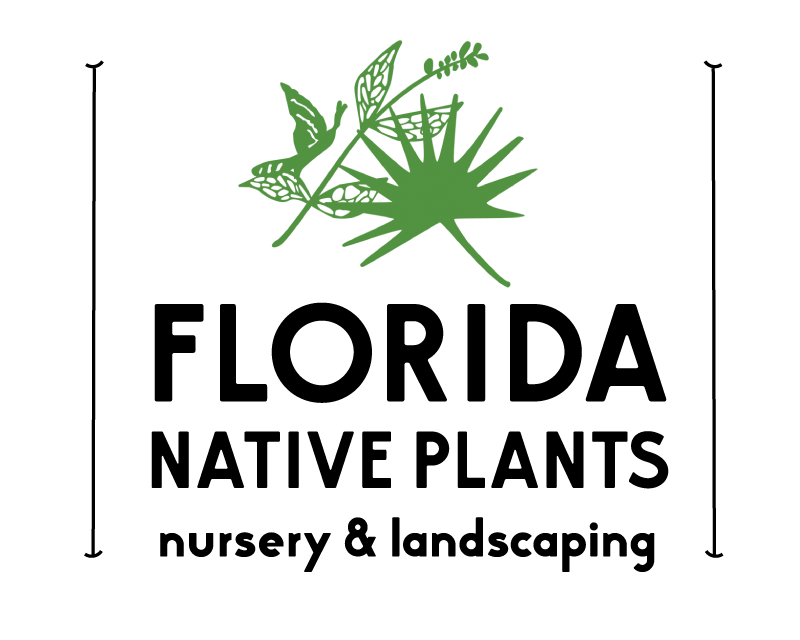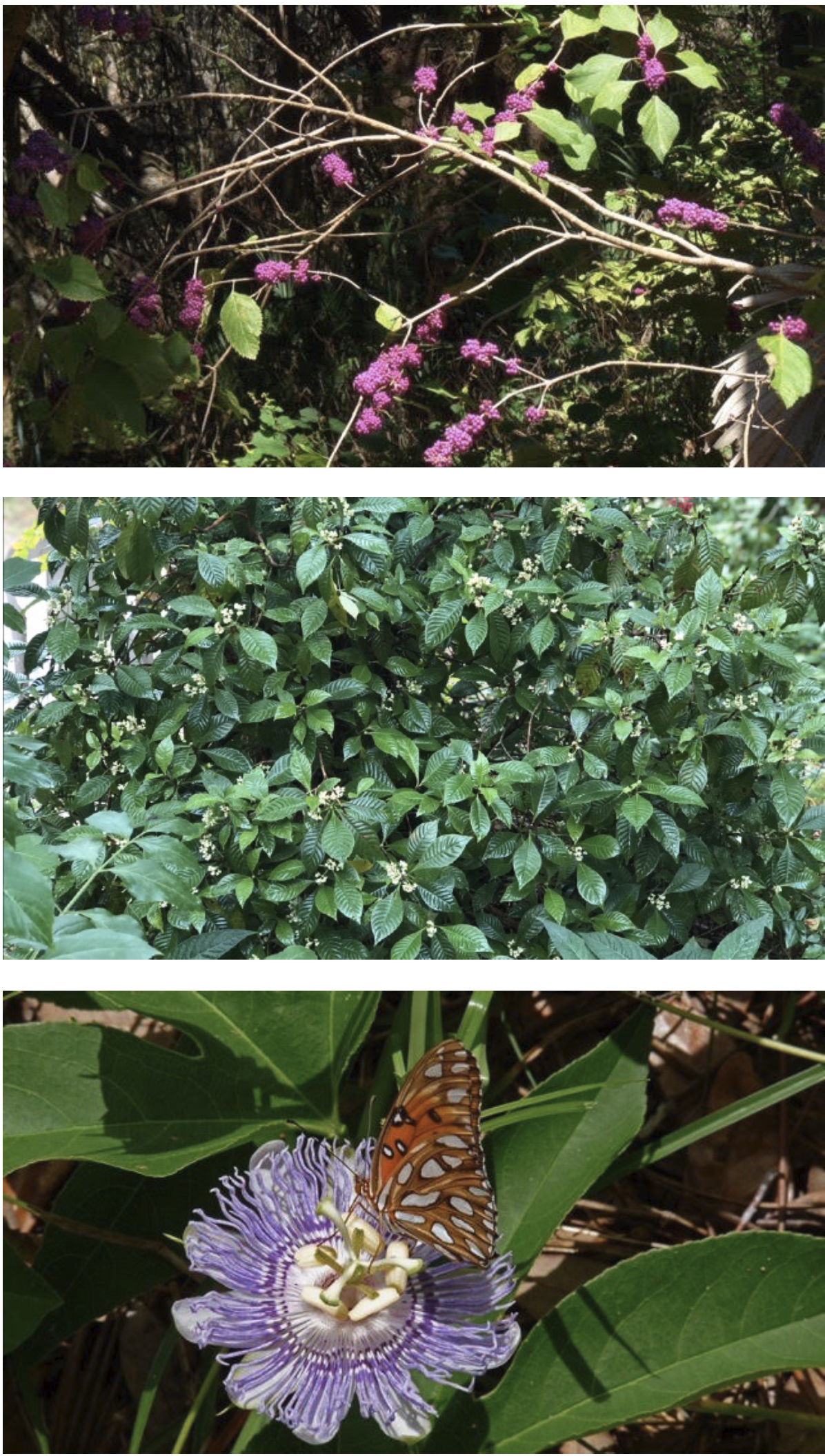Let's plant for them - Birds, Butterflies, Bees and Beneficial Bugs
Written by Laurel Schiller, Wildlife Biologist and Co-owner of The Florida Native Plants Nursery
with editing and photos by Fran Palmeri, Author, Naturalist and Photographer
and Annie Schiller , Co-owner, Co-manager and Landscape Designer for The Florida Native Plants Nursery
Pictured below: Florida native lantana, Lantana depressa var. floridana
Let's plant for them everywhere — our front and back yards, our schoolyards, churchyards, condo and apartment common areas and our civic centers.
Why? Because they will come and hopefully stay — and multiply — if we plant Florida native plants. These plants are locally adapted and hardy. They thrive without irrigation, fertilizers or pesticides. And they attract birds and butterflies to our yards, adding to the enjoyment of our surroundings.
Nature is in trouble in the Sunshine State. Florida continues to be a magnet for people. A thousand of us move here every day. By 2060, our population might double to 36 million residents. To accommodate them, seven million additional acres of land – an area equivalent to the state of Vermont – will have to be converted from rural to urban uses. Roads, shopping malls and subdivisions could replace more than 2.7 million acres of native habitat (Wildlife 2060: What's at stake for Florida. Florida Fish and Wildlife Conservation Commission 2008).
Unfortunately, when we move in, we take over. We clear, develop, change hydrology, suppress fire, pollute, spread pathogens, plant invasive species and indiscriminately use pesticides and herbicides which contribute to climate change. We are already experiencing hotter weather for longer periods of time, bigger storms, flood and drought, wildfires and a marked decrease in wildlife.
What do birds, butterflies, bees and other beneficial pollinators and critters do when we buy and develop a lot? Some species move elsewhere if there is an "elsewhere." Some species cope and adapt. Others become "locally extinct."
Silver Saw Palmetto in bloom at The Florida Native Plants Nursery in Sarasota, FL
We can do things differently.
First, we can protect natural areas/open spaces close to our neighborhoods so that those creatures who can’t adapt to us and our yards have somewhere to go.
Second, we can connect these natural areas to others by creating protected corridors of natural habitat plantings. Then the young of the year can move off on their own. Those looking for new territories can find them and those searching for new food supplies or mates will be successful.
Third, we can do a much better job of sharing the land with those creatures able to adapt to living with us. Our yards can serve as mini oases for them.
Here is how.
When building a home, clear as little as possible of the natural vegetation.
Treasure native pines and oaks, shrubs like wild coffee and beautyberry and native groundcovers.
Beautyberry and Firebush in bloom at the Audobon Center in Sarasota, FL.
All provide food and housing for critters.
Would it be too much to leave a little saw palmetto for the hundreds of pollinators which nectar on its blossoms?
Florida native plants are the natural resting, nesting, cover and food supply for our birds, butterflies and bees. Preserving native plants from the bulldozer will protect existing habitat for those creatures living there already. Your builder may not be happy but you will be when you see your landscape burgeoning with life versus a sterile grassy plot with a token tree or two.
If you are moving into an existing home on a vegetated lot or rethinking outdoor community spaces, find out which plants are native and keep them. To identify plants, refer to the websites of the Florida Native Plant Society, Florida Association of Native Nurseries, Florida Wildflower Foundation, and books like The Audubon Guide to Florida, and Priceless Florida. The Florida Agricultural Extension Service is another resource.
Remove invasive plants (to identify them, use FLIP: Florida Invasive Plant Species Mobile Field Guide). Limit exotic plants from other places in the world to a few “must haves.” These should not require additional water, fertilizers or insecticides to thrive. Most creatures won't nest, shelter or feed on exotic plants and are not attracted to yards filled with them.
And of course, when you are ready to add plants to your landscape or community space, plant natives.
You can do all this and have the color you crave.
The large, red tubular flowers of native firebush, which bloom most of the year, provide nectar for zebra longwing butterflies (our state butterfly), and colorful sulphur and swallowtail butterflies.
Muhly Grass, Seaside Goldenrod and Beach Dune Sunflower (top)
Prostrate Porterweed, Blanket Flower and Sunshine Mimosa (middle) note: also pictured in this photo is Gaillardia pulchella and according to the Florida Native Plants Society (https://www.fnps.org/plant/gaillardia-pulchella) “A series of studies in the last 10 years are suggesting that Gaillardia pulchella is likely not native to Florida. It is widely grown and naturalized in Florida especially near the coasts, but it is probably not native east of Texas (Weakley et al. 2020).”
Firebush with Zebra Longwing butterfly (bottom)
Beautyberry with berries (top)
Wild Coffee (middle)
Maypop Passionvine (bottom)
Ruby throated hummingbirds that migrate through Florida in spring and fall but sometimes stay all year will be delighted to find firebush in your yard.
Catbirds, mockingbirds and cardinals also love firebush fruit from late summer through fall.
Beautyberry, an all-season shrub, blooms in springtime, provides cover in summer and an abundance of porcelain purple berries through fall and winter.
Pollinators and birds relish beautyberry. If you plant one near a window, you will delight in “visitors” feasting off the blossoms and berries year round.
For a privacy border, plant native wax myrtle, hollies and cedars in North Florida and wild coffee, Simpson stopper and Florida privet in Central and South Florida. In spring, their blossoms attract pollinating insects, which songbirds feed to their vulnerable nestlings so they can grow quickly.
Residential and migratory songbirds seek after summer and fall fruit. All six of these plants provide dense cover to conceal nests from predators.
Consider using hardy vines to camouflage fences or walls. Coral honeysuckle, cross vine and maypop (native passionflower vine) produce colorful, nectar-rich flowers that bloom most of the year providing local wildlife with a reliable food source.
Here’s more nitty-gritty on creating a Wildlife (and Climate-Friendly) Yard (Adapted from “Audubon, Fall, 2019” with Florida Native Plant Nursery additions)
1. Kill the grass.
To make room for climate and bird-friendly habitat, you've got to lose some of that thirsty monoculture. We recommend sun blocking methods. Cut the grass as short as possible, cover with cardboard, dampen, and add five inches of mulch and wait two months before planting anything. Alternatively, place bags of sustainable commercial mulch end to end to block all sunlight, wait a month and then check weekly under it. When all sod is crispy dead, move mulch aside and plant. A third, quicker method-- rent a sod cutter.
2. Plant native species.
Look for homeowners in your neighborhood who have “gone native.” They’ll be sure to pass on a few tips on how they did it—plus even a cutting or two! Check out local parks to find out what’s growing there. Google “Natives for Your Neighborhood,” or "Audubon, Plant Natives" to find a list of recommended species for your zip code Strategically siting native trees and shrubs around your home can halve cooling costs over our very long, hot and humid, summers. Shade is welcoming and invites us to sit outside instead of indoors in air-conditioning, seven months of the year.
3. Go fertilizer-free.
Synthetic fertilizers typically provide more nitrogen than native plants need and microbes convert that excess into nitrous oxide, which, like CO2, traps heat in the atmosphere. Organic fertilizer is a little better, but using all-natural, composted materials is best. Leaf droppings in your yard might do the job.
4. Go pesticide-free.
Pesticides are indiscriminate poisoners. They kill beneficial as well as pest species, often many hundreds of feet away from the initial spray zone. Do not use them in and around your home, yard or on your plants. Instead, eliminate pest habitat. Dry out the ground beneath your overhangs and foundation walls by transplanting all plants six to eight feet away where there will be adequate airflow and rainfall. Sweep or blow leaf/ mulch litter away from your foundation. Do not allow tree branches to touch your roof or walls. Check out pesticide alternatives beyondpesticides.org.
5. Forget in ground irrigation systems.
Over 50% of our precious potable water supply in Florida (think about the strain on our aquifer from 36 million of us) is used to irrigate landscapes. You can water your native plants by hand during the establishment period. Once plants are established, you’ll save on water. After that natives planted appropriately will thrive on rainfall even during the hottest and driest months of the year.
6. Begin with the following hardy, easy to grow, perennial natives that will grow statewide.
They will flourish on their own in your yard in sun/part sun and provide a nectar-rich, flowering haven for birds, butterflies, bees --and you--for years to come. All of these plants will thrive in pots on your lanai, porch or in limited planting spaces.
Firebush: Large shrub or small multi- trunk tree to 12 feet. Abundant orange/red flowers spring through fall.
Coral honeysuckle: Vine or vine-like shrub. Salmon, tubular blooms spring through fall.
Climbing aster: Vine or vine-like shrub. Covered in purple blooms in fall.
Spotted Bee Balm: Semi-woody wildflower to 3 feet. Abundant purple blossoms summer through fall.
Spiderwort: Wildflower. Purplish blue blooms at intervals throughout the growing season.
Lyreleaf Sage: Groundcover. Carpet of blue flowers in early spring.
Seaside or Slender Goldenrod: Wildflower. Bright yellow blooms late summer through fall.
Starry Rosinweed: Wildflower. Yellow sunflower-like blooms on 2 foot stalks most of the year.
Sunshine Mimosa: Groundcover. Pink blooming puffs on stalks over foliage spring through fall.
7. Get them in the ground.
Group species with similar light, soil and moisture requirements together. Determine how large each individual plant will grow so you can space each accordingly. You will not need to amend the soil as native plants are adapted to our sandy conditions. Plant your native plants in natural groupings or disperse them throughout your yard or community space where their needs are met.
8. Mulch your newly planted areas to cool the soil, retain moisture and slowly release nutrients. Eventually, leaves falling from your native plants will be recycled.
9. When to plant?
All year in the southern half of the state, after danger of frost in North Florida.
Be committed.
Get started and keep on planting native.
Let your neighbors, community association, local churches and schools, civic spaces know what you are doing. Urge them to be copycats! Non-profits can apply for grants through some local chapters of the Florida Native Plant Society.
The outcome?
First and foremost is knowing you are creating an outdoor haven for other creatures as well as yourself, family, friends and neighbors.
All will be delighted by colorful butterflies wafting through yards and community spaces with birds providing the background music.
SINCE 1982 - Florida Native Plants Nursery and Landscaping
730 Myakka Road, Sarasota FL 34240 | floridanativeplants.com | (941) 322-1915 | info@floridanativeplants.com
Open 10am - 4pm Thursday through Sunday








